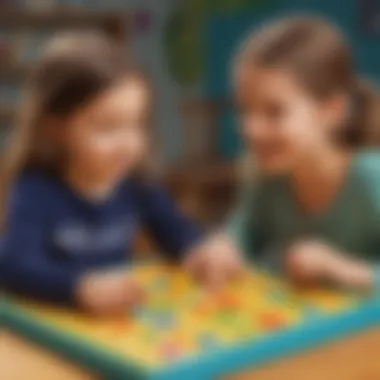Teaching Math to Kindergarten: Strategies for Success


Intro
Teaching mathematics to kindergarten students is a foundational task that influences how they perceive numbers and problem-solving. Early exposure to math concepts equips children with essential skills for their academic journey. In this article, we will examine various strategies for effectively teaching math to young learners. We will discuss creative activities, fun quizzes, and informative articles that support math learning in engaging ways.
Understanding the developmental characteristics of children in this age group is critical. Kindergarteners are naturally curious, and their ability to learn through play is impressive. Thus, using playful methods can make math learning enjoyable and effective. The importance of creating a positive learning environment will also be a central theme as we explore practical techniques for educators and parents.
Through this article, you will gain insight into how to create meaningful experiences that foster a love for numbers, enhance understanding, and promote lifelong learning in mathematics.
Prelims to Math in Kindergarten
Teaching math in kindergarten is significant for various reasons. It's a time when children begin to grasp the foundational concepts that shape their understanding of mathematics. Early exposure to math equips young learners with essential skills. They learn to recognize patterns, understand numbers, and begin basic operations. These skills are not just academic; they offer valuable tools for everyday decision-making and problem-solving.
The benefits of introducing math at this stage are profound. Children who develop strong early math skills tend to excel in later education. They build confidence which encourages participation in math-related activities. This positive reinforcement fosters a love for learning, which is crucial for lifelong education. As they explore numbers and concepts through play and engaging activities, their curiosity naturally grows.
Considerations also play a role in this educational journey. The methods used to teach math should align with children’s developmental stages. Educators need to recognize that each child learns at their own pace. By employing varied strategies, teachers can effectively reach diverse learning styles. In this way, kindergarten math is not merely a subject; it lays the groundwork for all future learning experiences.
The Importance of Early Math Skills
Early math skills form the foundation for later academic success. Children start with simple counting and progress to more complex concepts like addition. Research indicates that those who master these skills early perform better in school overall. It's not just about numbers, though. Early math teaches children how to think critically and analyze situations. This analytical thinking is crucial in our increasingly complex world.
In addition, early math promotes social skills. Children often engage in group activities where they share ideas or solve problems together. This collaborative approach encourages communication and teamwork. These skills are essential not only in academics but also in daily life.
Developmental Readiness for Math Learning
Developmental readiness is an essential factor when teaching math to kindergarteners. Each child’s readiness varies based on cognitive and emotional growth. It's crucial for educators and parents alike to understand these factors. Activities should cater to these developmental stages while encouraging exploration.
For instance, many children aged five years are curious and eager to learn. They can benefit immensely from hands-on activities that allow them to manipulate objects or use visual aids. Simple games that involve counting or recognizing shapes can spark enjoyment and understanding.
It’s essential for teachers to monitor children's progress. Adjusting methods based on individual needs ensures that all children meet learning goals. Therefore, a flexible approach in teaching math can significantly enhance learning outcomes.
Core Mathematical Concepts
Understanding core mathematical concepts is crucial in teaching kindergarten students. These fundamentals are not just about numbers; they form the foundation for future learning in mathematics. When children grasp these early concepts, they gain confidence, which is vital for their ongoing educational journey. Lack of a strong base can hinder progress in later years, making it essential to prioritize these concepts in early years.
Number Sense and Counting
Number sense refers to a child’s ability to understand, relate to, and work with numbers. It involves recognizing numbers, understanding quantities, and being able to count reliably.
- Recognizing Numbers: Children should first learn to identify numbers visually. This can be done using flash cards, number charts or even through apps designed for this purpose.
- Counting Skills: Children need practice in counting objects. Using real-life contexts, like counting blocks or fruits, helps them see the practical use of numbers.
Developing number sense allows children to explore mathematical relationships. For instance, if they can count to 20, they can better understand sequences, which is foundational for more complex math.
Basic Operations: Addition and Subtraction
Introducing addition and subtraction in an engaging way is key. Vocabulary such as add, plus, take away, and minus should be introduced gradually.
- Using Objects: Real-life objects such as beads or toys can illustrate both addition and subtraction. For example, you can show that if you have three apples and add two more, you can physically count out five apples to reinforce the concept.
- Visual Representation: Drawing can also be effective. Simple drawings of items can clarify what happens during adding or subtracting.
Incorporating these skills makes math relatable and foundation for more difficult problems later.
Patterns and Relationships
Patterns help children recognize sequences and predict outcomes. This skill enhances logical thinking as they notice repetitions in numbers, shapes, or sounds.
- Daily Activities: Teachers can integrate patterns into daily activities, such as noting the pattern in clothing or natural surroundings.
- Using Blocks or Beads: Children can create their own patterns with colored blocks or beads. This hands-on experience solidifies the concept of patterns as well as enhances fine motor skills.
Recognizing patterns builds the groundwork for algebraic thinking.
Measurement and Comparison


Understanding measurement involves gauging size, length, weight, and volume. Children must learn to use different tools and units, like rulers or cups, in educational activities.
- Hands-On Measurement: Letting kids measure ingredients in cooking or estimating the length of objects in a classroom promotes active learning.
- Comparative Learning: Children enjoy comparing their own heights or measuring school supplies. This makes learning more engaging and relatable.
Such skills will help them apply mathematical reasoning in various situations.
Shapes and Spatial Awareness
Fostering an understanding of shapes is vital. Children should learn to classify and describe two-dimensional and three-dimensional shapes
- Shape Sorting Activities: Using tangible items to sort different shapes helps solidify these concepts.
- Exploring Space: Activities involving movement, like obstacle courses, encourages understanding of spatial relationships.
Recognizing shapes and understanding space set the basis for geometry later in their education.
"Mathematical concepts in early childhood greatly influence children’s future relationships with math. Engaging experiences during these formative years are fundamental."
Teaching Strategies for Kindergarten Math
Teaching strategies for kindergarten math are crucial in establishing a strong foundation in mathematics for young learners. These strategies must adapt to the developmental levels of children. Engaging teaching methods can deepen understanding, stimulate interest, and offer positive experiences with math. This part of the article will outline various effective strategies that cater to diverse learning preferences, ensuring all students feel included and can thrive.
Play-Based Learning Approaches
Play-based learning offers an engaging way to teach math concepts. During play, children naturally explore and experiment. Incorporating games that involve numbers and shapes encourages them to learn without the pressure of formal instruction. For example, counting blocks while building towers or sorting shapes during play promotes hands-on learning.
Benefits of play-based learning include:
- Intrinsic Motivation: Children are more eager to participate.
- Social Skills Development: Group activities enhance collaboration.
- Critical Thinking: Kids face challenges that require problem-solving.
Integrating these methods ensures math learning is enjoyable, making it easier for children to grasp crucial concepts.
Incorporating Technology in Math Lessons
Technology plays an increasing role in education, even in early childhood. Using educational apps and interactive digital resources can captivate children. These tools often include games that teach counting or simple operations, making learning fun. It is common to see tablets in classrooms where kids participate in guided math activities.
Key considerations while using technology are:
- Age-Appropriateness: Ensure tools are suitable for kindergarten.
- Balance: Combine digital and physical learning.
- Hands-On Learning: Supplement tech activities with hands-on experiences.
When used mindfully, technology can enhance engagement and provide unique learning opportunities.
Using Manipulatives and Visual Aids
Manipulatives are physical objects that children can touch and move. Items like counting beads, blocks, or pattern tiles allow children to visualize mathematical concepts. These tools are essential for teaching number sense and basic operations.
Visual aids, like charts or pictures, also support understanding. For example, showing a dozen eggs can concretely demonstrate the concept of twelve.
Benefits include:
- Concrete Understanding: Helps abstract concepts become more relatable.
- Interactive Learning: Kids enjoy physically engaging with materials.
- Variety in Instruction: Cater to different learning styles.
By employing these techniques, educators can create a rich learning environment.
Storytelling and Mathematical Contexts
Integrating storytelling into math lessons can greatly enhance children's interest. When math concepts are embedded within a story, children relate to the characters and situations. For instance, a story about a character who needs to share apples among friends can introduce fractions or sharing concepts.
Storytelling also aids retention. Children remember exciting narratives better than isolated facts. This method provides:
- Real-World Connections: Shows how math applies in everyday life.
- Enhanced Engagement: Keeps children eager to learn.
- Increased Comprehension: Combines imagination with critical thinking.


By crafting or selecting relevant stories, teachers can make math meaningful.
Differentiating Instruction to Meet Diverse Needs
Every student has unique strengths and challenges. Differentiated instruction involves tailoring learning experiences to individual needs. For example, some children might grasp addition easily, while others may struggle. As a teacher, it’s important to assess where each student is and adjust your methods.
Strategies for differentiation can include:
- Flexible Grouping: Pair stronger students with peers needing support.
- Varied Activities: Offering different tasks based on skill levels.
- Personalized Feedback: Provide specific guidance to help each child improve.
Creating a supportive atmosphere where every child can succeed is vital.
In summary, implementing diverse strategies in teaching math to kindergarteners fosters an inclusive and effective learning environment. By utilizing play, technology, manipulatives, storytelling, and differentiated instruction, educators can engage students and build a strong mathematical foundation.
Creating a Math-Friendly Environment
Creating a math-friendly environment is pivotal in early education. It sets the stage for young children to explore mathematical concepts with confidence and curiosity. This environment encompasses both physical spaces and interpersonal interactions that promote learning. The conducive atmosphere encourages kindergarten students to engage actively in mathematical activities, fostering a positive relationship with numbers and problem-solving.
Designing Effective Learning Spaces
An effective learning space is tailored to the needs and interests of young children. Classrooms should be organized to facilitate movement, collaboration, and exploration. For instance, arranging furniture in flexible formations allows for group work and individual tasks.
Incorporating various zones—such as a math center with manipulatives, a quiet reading area, and space for hands-on activities—helps meet diverse learning styles. Items like colorful counting blocks, puzzles, and clipboards can make math tangible and fun. The layout should be open and inviting, encouraging students to engage with mathematical materials spontaneously.
The colors and decorations in the classroom can also play a role in creating a stimulating environment. Positive visual cues, such as number charts and shape displays, reinforce learning and spark interest. It is essential to regularly update materials to keep the environment fresh and engaging.
Encouraging Mathematical Discourse
Encouraging mathematical discourse among students is essential for deepening understanding. This involves creating opportunities for children to articulate their thinking, ask questions, and reason through problems collectively. Educators should model language related to math, using terms like "sum," "difference," and "more than" regularly during discussions.
Group activities, such as problem-solving tasks, can facilitate discussions about various approaches to a solution. Prompting questions like "How did you arrive at that answer?" or "Can you explain your reasoning?" encourages students to listen, reflect, and learn from one another. It also instills the idea that mistakes are a part of learning, making them feel comfortable sharing their thoughts without fear.
Additionally, incorporating storytelling that integrates mathematical concepts can spark conversations. For example, reading books that involve counting or shape recognition can provide a context for discussions. This enables students to connect math to everyday experiences, enriching their discourse.
Fostering a Positive Attitude Towards Math
Fostering a positive attitude towards math is key to long-term success in learning. Children often form their perceptions of math based on early experiences in the classroom. Therefore, creating an encouraging environment is necessary to instill confidence.
It is crucial that educators celebrate small achievements. Recognizing efforts rather than just correct answers helps build self-esteem. Creating a culture where collaboration is encouraged, rather than competition, allows students to thrive.
To further enhance attitudes towards mathematics, integrate fun and challenging activities into lessons. Use games that involve math, such as board games that include counting or currency, to show how math is relevant in play and real life.
Here are some practical ways to foster a positive math environment:
- Provide resources that emphasize math skills through play.
- Encourage peer learning and group projects to build teamwork skills.
- Use affirmations and positive reinforcement regularly.
Creating a math-friendly environment is a crucial step in nurturing young children's mathematical abilities. By thoughtfully designing spaces, promoting discourse, and fostering positive attitudes, educators can lay a strong foundation for the future mathematical learning of their students.
Assessing Mathematical Understanding
Assessing mathematical understanding in kindergarten is a crucial part of the teaching process. It goes beyond simply checking if students can recite numbers or add two plus two. Effective assessment provides insights into a child's comprehension of fundamental math concepts. Understanding where a student stands in their learning journey allows educators to tailor instruction to meet diverse needs. Moreover, assessments can identify gaps in knowledge, helping to ensure that no child falls behind.
Assessments also foster a strong foundation for future learning. Early experiences with math can influence attitudes towards the subject later in life. When children feel confident about their math skills through regular assessment and feedback, they are more likely to develop a positive relationship with math. This nurturing environment encourages exploration and boosts engagement in learning.
In this section, we will discuss two types of assessment techniques that are particularly effective in kindergarten: informal assessment techniques and tracking progress and growth. These methods focus on engaging students in ways that align with their natural learning styles, rather than relying solely on traditional testing methods.
Informal Assessment Techniques
Informal assessment techniques are non-intrusive strategies that help educators gauge a child's understanding while they are actively learning. These methods can take many forms, such as observations, discussions, or interactive activities.


Key informal techniques include:
- Anecdotal Records: Teachers can jot down notes on students' performance during activities. This provides context for their skills and approaches to problems over time.
- Math Journals: Encourage students to express their thoughts through drawing or writing in a math journal. This reveals their understanding in a creative way.
- Games and Activities: Using fun and engaging games allows teachers to assess skills naturally. Observations during these activities can highlight areas of strength and those needing improvement.
- Questions and Conversations: Engaging students in dialogue about their thought processes can uncover their understanding. It also builds communication skills.
Informal assessments help create a low-pressure environment for young learners, allowing them to demonstrate understanding without the stress of formal testing.
Tracking Progress and Growth
Tracking progress and growth in students helps teachers maintain a clear view of individual and group performance. It also provides benchmarks to celebrate achievements and address challenges promptly. This ongoing observation contributes to a responsive teaching approach.
Consider these vital aspects when tracking progress:
- Data Collection: Regular collection of data through informal assessments aids in monitoring students' skills. This could involve grading math journals or recording observations during group activities.
- Learning Goals: Establishing clear learning goals helps in measuring progress. Goals should be specific, achievable, and flexible according to individual student needs.
- Feedback Loops: Offering timely and constructive feedback encourages students to improve. It also reinforces their understanding and motivation to learn.
- Parent Involvement: Sharing progress with parents fosters a home-school connection. Parents can continue to support their children's learning at home.
By implementing these strategies, educators not only enhance their understanding of mathematical development but also create an environment that facilitates continuous growth. The dual focus on informal assessment techniques and tracking progress ensures that teaching remains adaptable and student-centered.
Collaboration with Parents and Families
Collaboration between educators and families is essential in cultivating effective math learning environments for kindergarteners. The involvement of parents enhances not only the educational experience of children but also fosters a supportive home atmosphere where mathematics can be valued. This connection ensures that children receive consistent messages about the importance of math, thus reinforcing learning that occurs in the classroom.
Engaging with families also provides educators with insights into the strengths and challenges that each child may face. Additionally, sharing responsibility creates a partnership that motivates and empowers both parents and educators. This partnership fuels a holistic approach to education where parents feel connected and informed about their child's learning journey.
Importantly, good communication is a cornerstone of collaboration. Regular updates and discussions about learning goals and progress can help parents support their children at home effectively. This can also alleviate any concerns parents may have about their child's performance, leading to a more positive overall experience.
Collaboration with parents has a significant impact on children's academic outcomes. Research indicates that when parents are involved, children show improved achievement levels and increased motivation in learning.
Engaging Families in Math Activities
Engaging families in math activities at home can be a powerful way to reinforce concepts learned in the classroom. Simple, everyday activities can transform mundane routines into meaningful learning experiences. Encouraging parents to include math in daily life can create a culture of learning that extends beyond school.
Here are several activities that families can do together:
- Cooking and Baking: Measuring ingredients introduces concepts of volume and fractions.
- Shopping: Budgeting for groceries can help develop skills in addition, subtraction, and even some basic multiplication.
- Board Games: Playing games that require counting or strategy can strengthen number sense and problem-solving abilities.
Using these activities, parents can help children see the relevance of math in real life, making the subject more relatable and enjoyable. Providing parents with a list of such activities can facilitate these engagement opportunities.
Resource Sharing with Parents
Sharing resources with parents can empower them to become better advocates for their children's learning. Offering newsletters, access to educational websites, and engaging online platforms creates a repository of knowledge that families can draw from.
Some beneficial resources include:
- Online Math Games: Websites like PBS Kids and Cool Math Games can make math practice fun.
- Educational Apps: Suggesting apps like ABCmouse or Prodigy can aid parents in providing structured, playful learning experiences.
- Printed Materials: Worksheets and math games that can be printed from various educational websites allow for offline learning.
To further enhance this sharing process, schools can host workshops where parents learn about effective math strategies and tools. Such workshops not only build skills but also create a community of learners, fostering a network of support.
Finale: The Path Forward in Kindergarten Math
In the pursuit to nurture young learners, the conclusion of this article emphasizes the critical need for educators to foster a love for mathematics. Building a strong foundation in math during the kindergarten years directly influences a child's future academic trajectory. A structured approach that encourages curiosity about numbers can lead to long-term engagement with math concepts. The implication here is clear: sustaining interest is just as important as the knowledge itself.
Another significant aspect is recognizing the diverse needs of kindergarten students. Educators must adapt their teaching methods to cater to individual learning styles. This flexibility ensures that all children can grasp fundamental concepts at their own pace. By focusing on inclusive practices, teachers can create an environment where every child feels confident and valued.
Sustaining Interest and Motivation
Sustaining interest in mathematics requires continuous effort from educators. Engaging children through varied and stimulating activities leads to better retention of mathematical concepts. Here are some strategies to maintain interest:
- Routine Changes: By regularly changing activities, students may discover new interests within math. For example, alternate between hands-on activities, group work, and technology.
- Real-World Applications: Mathematics can seem abstract. Relating math to everyday experiences allows children to see its relevance. Activities that involve shopping or measuring ingredients can make numbers come alive.
- Positive Reinforcement: Frequent encouragement and positive feedback can foster a love for learning. Recognize effort and improvement, rather than focusing solely on correct answers.
"Engaging children in meaningful math experiences can spark long-lasting interest and promote critical thinking skills."
Next Steps for Educators
To sustain momentum in math education, educators should consider the following next steps:
- Professional Development: Ongoing training can help teachers learn about the newest strategies in math education. Workshops focusing on play-based learning, technology integration, and assessment techniques are invaluable.
- Feedback Mechanisms: Implementing channels for feedback from both students and parents can provide insights into what is working well and what might need adjustment.
- Collaboration: Teachers can benefit from sharing best practices with colleagues. Creating a community of practice can facilitate innovative teaching strategies and resources.
- Utilizing Resources: Investigate educational platforms and websites that offer activities and materials tailored for kindergarten math learning. Websites like Wikipedia or Britannica provide a wealth of information on diverse educational methodologies.
- Parental Engagement: Encourage parents to participate in their child’s learning journey. Providing them with resources or activities they can do at home reinforces classroom learning and maintains interest.







